Leaning against a big old log while eating lunch, I felt vaguely uneasy. It reminded me of a big driftwood log I’ve sat by on a beach in Oregon, except this log was solid rock. I was in the Petrified Forest National Park, following up on a research reconnaissance I made here last October, again looking for possible examples of ancient fire scars in these amazing fossil forests.
In an earlier story I described how, by chance, a piece of petrified wood from southeastern Utah that I found with my dad about thirty years ago turned out to be a fossil fire scar, the first ever recognized or described. I also wrote about how that unexpected finding led to a deliberate search, in October of last year, for ancient fire scars in the Petrified Forest of Arizona. In that reconnaissance we found ten petrified logs with possible fire scars, including two very promising ones in the northern section of the park, called the Black Forest because of the predominance of black mineralization of the petrified wood in that area.
One of those possible scars was on a piece a petrified log small enough to move under human power, and if we could remove it we could have it cut in cross section so that a careful examination of clues in the internal anatomy of the wood could determine whether or not the external pattern was indeed an ancient fire scar. The potential fire scar spanned five broken sections of a log. The piece we were planning to carry out was the middle, and smallest, of the three upper sections. Although only about eight inches high and a foot in diameter, it weighed almost sixty pounds, a good load for our backpack. The section above it showed an arched “catface” pattern that looked almost like those often seen in modern fire scars. The lower sections reached down to the roots of the fossil tree, also similar to a modern fire scar.
Eating lunch by that petrified log, what popped unexpectedly into my mind was a painting by Claude Monet that I had seen in a special exhibition at the National Gallery of Art in Washington: Le Déjeuner sur l’herbe, usually translated as “Luncheon on the Grass.” Monet captured a moment in time on a faraway afternoon just before the picnic started. From the way the light looks falling through the leaves, I guess it was early fall. The expressions on the faces are a subtle snapshot of the relationships of the picnicking couples.
We were picnicking too, but around us were only a few dry bunch grasses. No leafy shade, no white picnic cloth, no roast chicken, fruit, or bottles of wine. Only eroding clay hills and the sparse survivalist vegetation of these Late Triassic badlands. There is a feeling of harshness and unfriendliness here that for me is even stronger than in the rock-ice-snow landscapes of the mountain high country in winter, which somehow seem friendlier. The Black Forest is surreal, almost Martian.
It wasn’t really frightening in any conventional sense. We had plenty of water, and knew how to get back to our car, parked at the Painted Desert Inn. What was uncomfortable was that trying to grasp the almost unimaginable changes that have occurred right here at this exact spot exaggerates the feeling of the ephemerality of life almost to an extreme. The sense that our lives are an eyeblink in time, or a dream, calls into question their existential meaning. What was I doing here, in this surreal landscape, on this changing planet, in this vast Universe? Eating lunch. Picnicking in deep time.
For me, and probably for most people, the concept of “deep time” is a little uncomfortable. Deep time could perhaps be defined as time reaching back way beyond human history, into the realm of prehistory, evolutionary time, and cosmic time. It contrasts with what could be called “shallow time,” although no one has to my knowledge used that phrase. Everything we normally think of as history, and our own lives and those of our immediate ancestors, are in the shallow part. Deep time makes you feel pretty small and insignificant.
Henry Thoreau, at his cabin at Walden Pond in the summer of 1846, wrote in his journal that “Even time has a depth, and below its surface the waves do not lapse and roar.” The present moment in time, he implied, is a surface exposed to winds – winds that make waves on water, or drive fires through forests. But below that surface, in the depths of time, is a kind of calm, he seemed to say.
I thought of John Muir and his encounter with the Petrified Forest, in 1905 and 1906, and again briefly in 1909. A writer who accompanied Muir and John Burroughs on a trip to the Petrified Forest in 1909 wrote “That very forest to which we went on that first day, and where we ate our luncheon from the trunk of a great petrified Sigillaria, had been discovered by Mr. Muir and his daughter a few years before as they were riding over the sandy plateau. He told us how excited he was that night–he could not sleep, but lay awake trying to restore the living forest in imagination.” Muir was already an experienced deep-time traveler when he first came to the Petrified Forest. He had discovered modern, living glaciers in the Sierra Nevada of California, studied their more active giant cousins in Alaska, and run the film of geological time backwards in his mind to understand how ice had sculpted the grand granite formations of the Yosemite over the eons. He was prepared to imagine a modern desert landscape once covered by forests from his experience imagining a modern forest landscape once covered by ice.
I can imagine Muir trying to hear the sound of the wind in the needles and branches of these stone trees. Muir wrote about the sound of wind in ponderosa pines – my own favorite tree because I grew up in the pine woods of northern New Mexico: “This species also gives forth the finest music to the wind.” I think of him lying awake all night imagining wind music in Triassic trees. I try – and almost think I hear – some ancient conifer music in the strong wind sweeping the Black Forest on this warm April day, keeping us comfortable as we eat lunch in the strong sun.
Here, where I’m eating my cheese, crackers, apples, and chocolate, a wildfire may have been raging in a forest 210 million years ago. I can imagine the flames sweeping through, carried by ground-level vegetation and burning many of the trees, but only scarring the one nearby, which survived and continued to grow, recording the event in a fossil fire scar that we see now from its petrified shape. The cut an polished cross section of this piece of petrified log that we are about to carry out will give us a time-lapse snapshot that we can see and interpret, reading the tea leaves back into deep time, to answer the question “was this an ancient fire?” I guess you could say we are trying to have a conversation with deep time: “Hello. What was it like on Earth back then? Same as now, or different?”
If you want to feel really alone, go sit by a big old log in the Black Forest. I don’t mean “alone” in the usual sense of not with anybody else you know, or even anybody else at all, whether you know them or not. I mean alone by yourself in the Universe. Here it’s easy to have a sense of wandering on the shores of the ocean of time, sitting by a driftwood log, where existential predators prowl hungrily, looking for a morsel of living, timebound flesh. Like mine. Like yours.
All of us, everyone, needs to have a picnic in deep time.
Why? Because deep time is the antidote to the poison of human hubris, an antibiotic against the life-threatening infection of our anthropocentric culture. A picnic in deep time can provide a chance to step back from the frenzy of our lives now, and gain a perspective on our ephemerality as individuals and as a passing species on a tiny planet in a dynamic Universe. More than anything else we need humility. We act like we own the planet and imagine we control it. Deep time teaches that the opposite is the true nature of our human condition.
The Black Forest sucks at the brain, and makes me glad to climb the steep switchbacks out of Lithodendron Wash, even with a backpack heavy with a chunk of petrified wood: to shallow time again, to the historic Painted Desert Inn, to the hot car, to today, to now, to what we do next.
For related stories, see:
Related links:
- Le Déjeuner sur l’herbe, 1865-1866, Claude Monet, Musée d’Orsay, Paris.
- John Muir and John Burroughs in the Petrified Forest, 1909

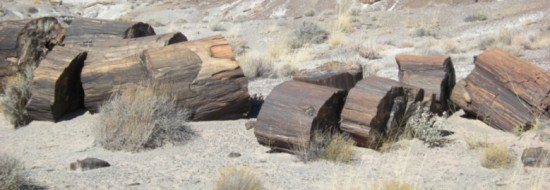
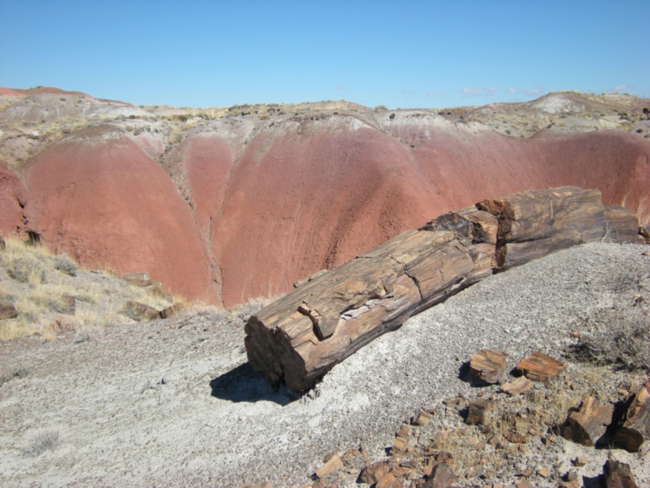
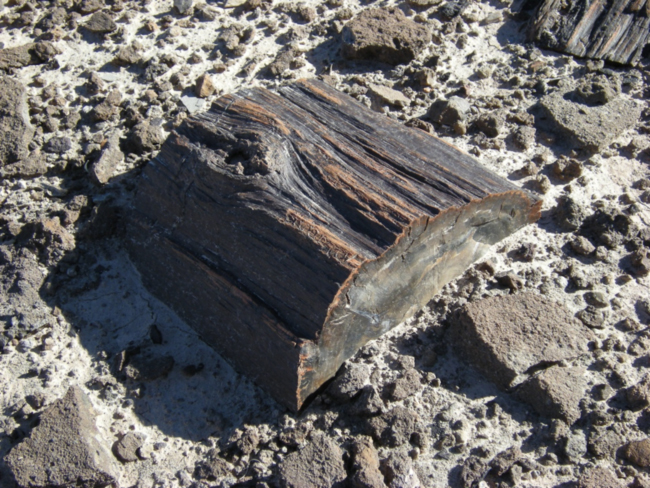
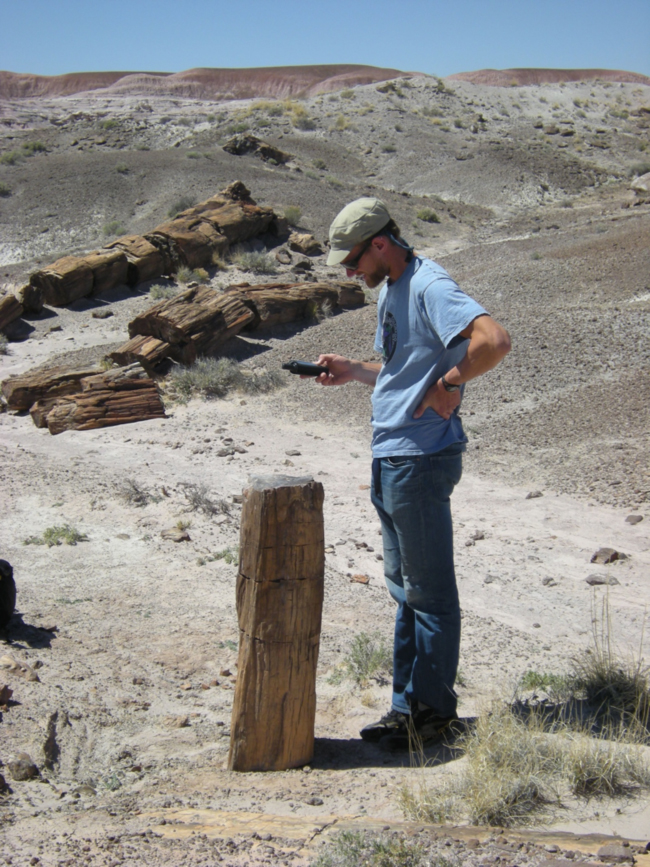
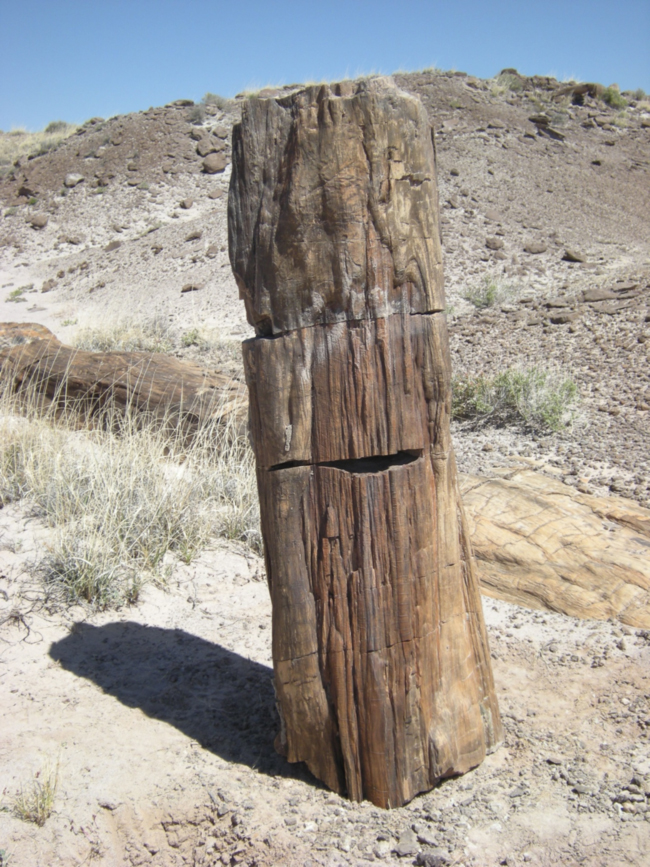
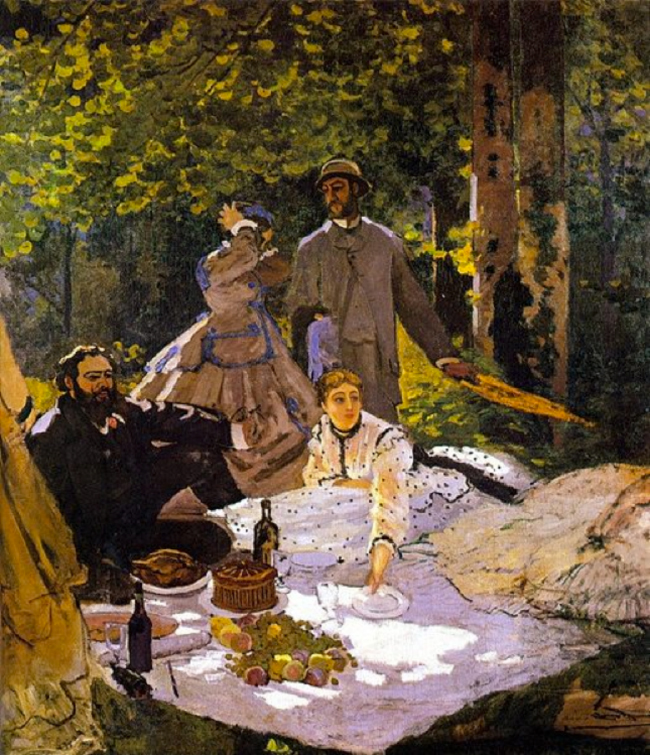
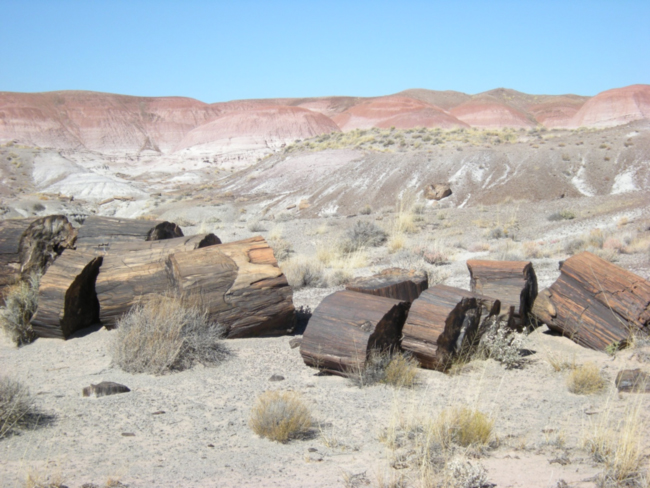
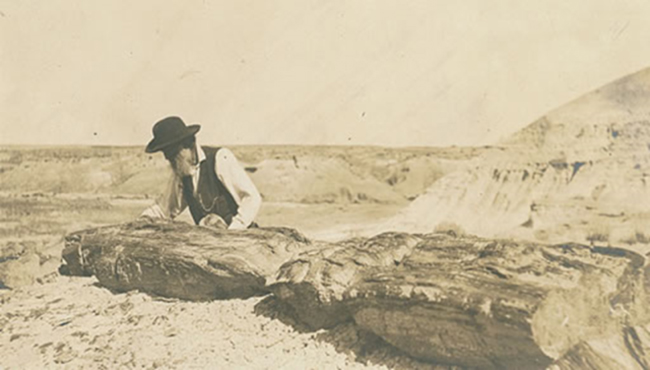
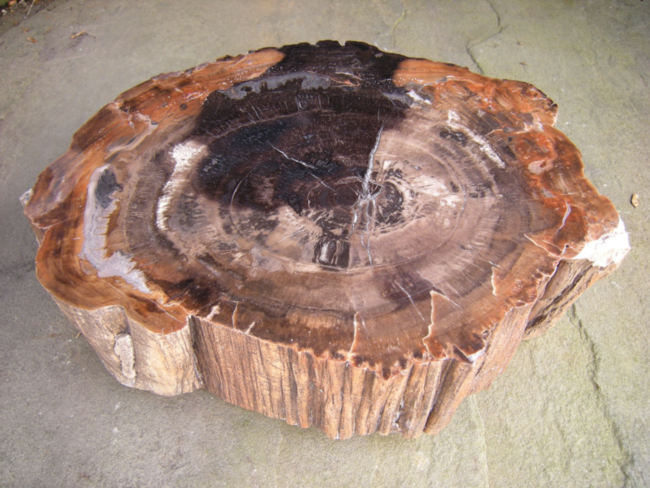
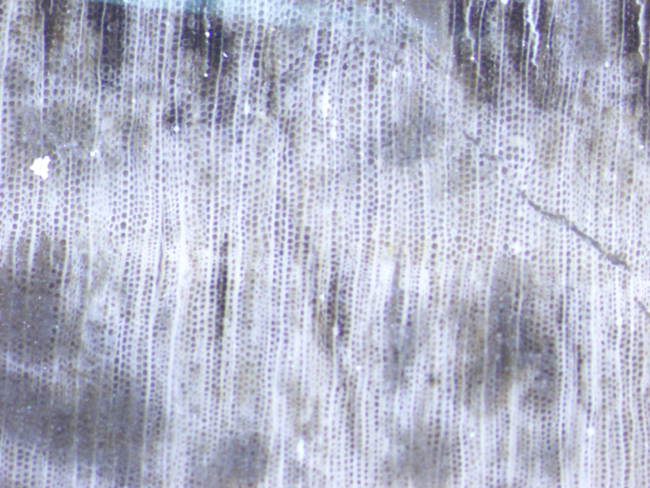



June 9, 2014 1:10 am
hey Bruce – really enjoyed this one – very informative and thought provoking!
June 9, 2014 1:29 am
Thank you for the positive feedback, Erik. I’m glad you enjoyed this.
June 9, 2014 1:12 am
Beautiful, Bruce. Always enjoy your essays, but this one struck a particularly resonant chord.
dave
June 9, 2014 1:32 am
Thanks Dave. Of course I would expect you to have a resonant ear for “deep time” chords — you helped tuned my own ear to them, after all! Thank for all that too. Bruce
June 9, 2014 10:18 pm
Dear Bruce and Jonathan,
Always when I read your blog it’s an Amazing travel to history of nature, history of life and or human being.
Thanks for keeping doing this magnificent studies and adventures.
regards,
sergio
June 12, 2014 11:59 pm
Sergio, we’re glad you enjoy the stories of our travels and research, and we thank you for your part in some of them! One goal is to visit a petrified forest in Argentinian Patagonia, not so far from you, really — the Cerro Cuadrado Petrified Forest, near Puerto Deseado, in Santa Cruz Province, Argentina. Fossil wood and cones of an extinct Araucaria from the Jurassic, Araucaria mirabilis, are found there. Un cordial saludo, Bruce
June 9, 2014 10:26 pm
Dear Bruce and Jonathan,
Always when I read your blog it’s an Amazing travel to history of nature, history of life and or human being.
Thanks for keeping doing this magnificent studies and adventures.
regards,
Sergio
June 11, 2014 1:49 pm
Dear Bruce,
Another insightful and beautiful post about a place I know well. Having grown up in Arizona and spent years wandering the Sonoran deserts of the south and the wonderlands of the Colorado Plateau, my reaction to those photos is one of longing for that peaceful austerity. Although I know what you mean by “harshness and unfriendliness” – that environment is also unforgiving of our hubris. The people for whom that country is ancestral certainly embody that deep time perspective you describe so well.
Thanks so much for sharing these stories.
Greg
June 13, 2014 12:17 am
Greg, I’m glad you enjoy these stories of travels and adventures in both shallow and deep time. You understand that Black Forest deep-time landscape well (no surprise to me): how those environments that are, as you say, “unforgiving of our hubris” can also let us relax into a sense of “peaceful austerity.” What, maybe something like sunbathing on the beach of deep time? Best wishes, Bruce
June 12, 2014 7:54 am
Siempre fabuloso Mr. Bruce, Felicidades!Por favor siempre incluyeme en tus estudios, cada vez aprendo mucho.
Victor desde Honduras C.A